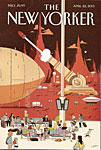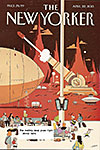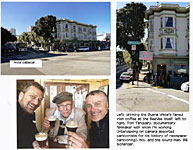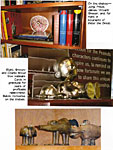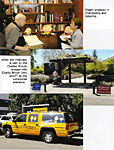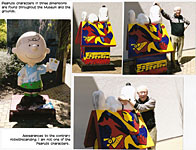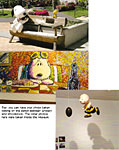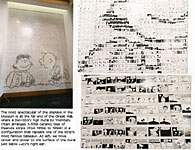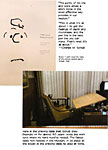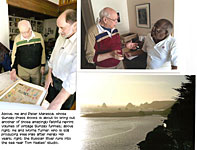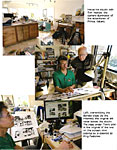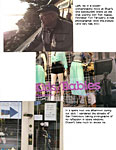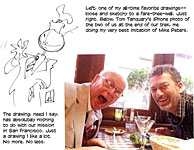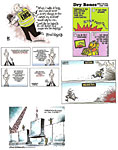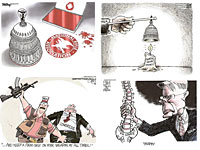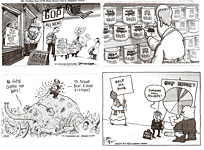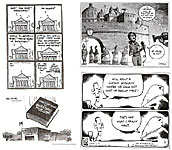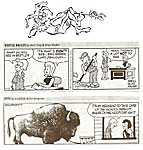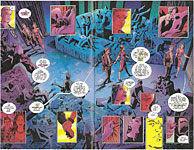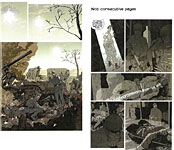 |
||||||||||||
Opus 309 (April 26, 2013). Our main event this time is a report on a new documentary on newspaper comics that’s underway, with Harv’s involvement as interviewer during a visit to cartoonists and historians in the San Francisco vicinity: we visited Comic Art Museum’s curator Andrew Farago and took copious photographs (all on display herewith) of the Charles Schulz Museum and cartoonists Tom Yeates and Morrie Turner, and Jean Schulz at her husband’s studio. We also announce the winner of the Pulitzer for editorial cartooning and some other winners in other editoon competitions and exhibit some of the best editorial cartoons on the Boston bombing and the failure of the U.S. Senate and review Sex and Sledgehammer and Daredevil: The End of Days. Here’s what’s here, in order, by department:
NOUS R US New Yorker Mailing Label Fixed Doonesbury in Boulder
THE AWARD SEASON Steve Sack Gets Pulitzer Headliner Winner, Steve Breen Pat Bagley Bags Best of the West
True Story of Mormon Crickets By Pat Bagley
Milton Knight on Academic Comics
DOCUMENTARY FILM ON COMICS By Tom Tanquary and R.C. Harvey Prospectus: Hand-drawn Life Photo Report on San Francisco Visit Charles Schulz Museum and Studio Sunday Press’s Peter Maresca Prince Valiant’s Tom Yeates Wee Pals’ Morrie Turner
EDITOONERY Some of the Best of the Month Boston Bombing Gun Control Failure
RCH Essay: Terrorism Bombs in Boston
THE FROTH ESTATE Boston Bombing Not “Well Coordinated” Misconduct of the Press from Felltoons.com
NEWSPAPER COMICS PAGE VIGIL Toni and Brad Engaged Garfield, Pearls, Funky Shower Curtain Beetle and Zits
FUNNYBOOK FAN FARE Sex Sledgehammer Daredevil: The End of Days
Our Motto: It takes all kinds. Live and let live. Wear glasses if you need ’em. But it’s hard to live by this axiom in the Age of Tea Baggers, so we’ve added another motto:.
Seven days without comics makes one weak. (You can’t have too many mottos.)
And our customary reminder: don’t forget to activate the “Bathroom Button” by clicking on the “print friendly version” so you can print off a copy of just this installment for reading later, at your leisure while enthroned. Without further adieu, then, here we go—:
NOUS R US Some of All the News That Gives Us Fits
No cartoonists made it to Time’s annual list of “The 100 Most Influential People in the World.” Neither did any of the Mexican drug cartel moguls; surely, they’re influential? If it’s any comfort, however, Time named R.C. Harvey Person of the Year in 2006 (along with every other Internet user who was creating content on the Web). Ahhh, fame—how fleeting. We pause here to recognize an Advance in Civilization. For years as a subscriber, I’ve complained (often to the art director, Francoise Moulay) about the mailing labels on the covers of The New Yorker. The labels cover up a small piece of the cover art. And at least once—on a cover by Sempe—the label covered the visual punchline. And if you try to peel the label off so the artwork can be viewed without obstruction, the peeling rips off a piece of the artwork. This seems negligent to an almost criminal extent. Not only are readers deprived of a view of an entertaining drawing, but the magazine is sabotaging itself. Presumably, The New Yorker pays a bodacious penny for the art on its cover. And yet, it persists in a practice that deliberately blemishes that expensive art. Other magazines that I get have labels on the cover, too, so The New Yorker is not the sole offender in magazine journalism. But it is the most egregious because it so clearly values its cover as a showplace for ingenious artistic endeavors. I once recommended that the mailing label be affixed to the back cover; and to foreclose on the advertiser’s complaint, a strip across the bottom of the back cover could be left blank for attaching the label—that way, it wouldn’t (the gods forfend!) obliterate a piece of sacred salesmanship. (In effect, the back cover ad would be a few cubic inches smaller, but the magazine could still charge the same fee: it’s position, not size, that makes the back cover desirable.) No one grabbed at that remedy. Other magazines use mailing labels the glue of which adheres the label to the cover but still permits the label to be peeled off without taking portions of the cover illustration with it. And now—at last!—The New Yorker has joined that throng. You’d think a magazine of advanced thinking and artistic sensibility would have found a solution to its most glaring (because most visible) problem, but, no, apparently it’s taken years. Ms. Moulay once explained, when I assaulted her with my usual complaint, that the machinery that affixes mailing labels was too complicated to change. Made no sense, of course; but she’s an art critic, not a mechanic. Now, the machinery (or whatever was the problem—I say, the glue) has been adjusted, and I can peel off the label and see cover art in all its gorgeousness.
Doonesbury in Boulder. Zonker Harris, a mellow but dedicated stoner in Garry Trudeau’s strip, apparently keeps up with the news of the day, wherein he found that weed is legal for recreational purposes in Colorado (the state in which these wholesome remarks originate). So Zonker is going West, youngsters, where he, with slacker nephew Zipper in tow, plans to become a “bajillionnaire” with a “sweet little grow outside of Boulder.” Boulder is the place that hosts a national “smoke out” (or is it a “smoke in”?) annually. A monster smokey was conducted in Denver’s civic center on April 20, but it was disrupted by a gunman who fired his weapon and wounded a couple people. Perhaps gang related. Investigation proceeds apace. The part I liked best about the “4/20" festivity was that at precisely 4:20pm, everyone exhaled, creating a huge maryjane cloud just in front of the state capital building.
For exhaustive comics news, consult these four other sites: Mark Evanier’s povonline.com, Alan Gardner’s DailyCartoonist.com, Tom Spurgeon’s comicsreporter.com, and Michael Cavna at voices.washingtonpost.com./comic-riffs . For delving into the history of our beloved medium, you can’t go wrong by visiting Allan Holtz’s strippersguide.blogspot.com, where Allan regularly posts rare findings from his forays into the vast reaches of newspaper microfilm files hither and yon.
THE AWARD SEASON Steve Sack of the Star Tribune, Minneapolis, won the Pulitzer Prize for editorial cartooning this year, the official announcement citing him “for his diverse collection of cartoons, using an original style and clever ideas to drive home his unmistakable point of view.” Gobbledegook of the sort judges in these competitions usually blather. “Original style,” “clever ideas,” and “unmistakable point of view” are what we could say about any editoonist anywhere. Almost. The description of the category isn’t much better: the Pulitzer is awarded, it sez, “for a distinguished cartoon or portfolio of cartoons, characterized by originality, editorial effectiveness, quality of drawing and pictorial effect, published as a still drawing, animation or both.” In other words, animated editorial cartoons can win; and, indeed, some have. The prize is accompanied by $10,000. Finalists were Clay Bennett of the Chattanooga (Tenn.) Times Free Press for “polished, witty cartoons that effectively lampoon prominent leaders and groups in a polarized America”; and Jeff Darcy of The Plain Dealer, Cleveland, for “his fresh portfolio of cartoons that feature deft caricatures and leave no one guessing where he stands on important issues.” Well, sure. You gotta say something. I’d
add that Sack has been at the Star Tribune since 1981—that’s 32 years at
the drawing board, and all in the same venue. He deserved to win the Pulitzer
much earlier, I’d say, for artistic experimentation if nothing else. He was
among the very first cartoonists to realize that digital reproduction permitted
him greater flexibility as an artist. Early on in the ether age, he began
drawing his cartoons differently—because he could. For a while, he drew with
colored pencil. He eventually returned to inking with a bold line, but he still
seems to be using a colored pencil for some tonal variety in his pictures,
sometimes with striking effect. At the elbow of your eye, we’ve posted a
sampling of his recent work. Bennett’s name came up again as placing third in the National Headliner Award, which was won this year by Steve Breen of the San Diego Union Tribune (his second time winning this one); Newsday’s Walt Handelsman took second place. The Headliner Award, the invention of the Atlantic City Press Club, is one of the oldest awards in journalism: the first were conferred in 1935. Why the Atlantic City Press Club has all this prestige is beyond me, but there it is.
BAGLEY A WINNER (Well, here at Rancid Raves Intergalactic Headquarters, we’ve always known that) In this year’s Best of the West competition among 13 western states in journalism (breaking news, page design, explanatory reporting, and so on), the Salt Lake Tribune’s Pat Bagley won first place in editorial cartooning with a portfolio of cartoons on such topics as the NRA’s grip on Congress (we’re posting that cartoon below in our Editoonery department), the gay-friendly Mormon Church, and the bulldozing of public lands. “Pat Bagley hits the bulls eye with his bold strokes and rollicking sense of humor,” said Politico’s Matt Wuerker, the judge for editorial cartooning. “He brings clever insight to the pressing issues of the day that he illuminates with brilliant color and true wit.” David Fitzsimmons of the Arizona Daily Star (another big favorite hereabouts) took second with his portfolio, which includes spoofs on global warming deniers, Fox News coverage of President Obama, and Senator Todd Akin’s controversial remarks on abortion. “Fitzsimmons has a naturally comic voice that comes through with his brash palette and goofy visual style,” said Wuerker, the current president of the American Association of Editorial Cartoonists. Matt Bors, syndicated without a home paper, snagged third with his collection of cartoons ranging from Native Americans’ commentary on a certain statistic to the Stand Your Ground law to the proposal to arm school officials. Said Wuerker: “Bors has an unmistakable and refined style that’s all his own. He brings a biting point view and acid wit to his visual commentary that makes him a real stand out in the field.” Wuerker’s remarks are, themselves, award-worthy: he actually says something about what makes each cartoonist’s work unique. The winners competed against 13 other editoonists.
PAT BAGLEY AND THE TRUE STORY OF THE MORMON CRICKETS And before we leave Pat Bagley (Mormon Emeritus, as he calls himself) to other devices, not to mention his drawing board, here’s a sample of the sort of thing he commits at his blog—: My favorite Mormon pioneer story is the one where dinosaurs arrive just in time to eat the grasshoppers that are threatening the pioneers’ crops. The Saints are saved and, in gratitude, erect a monument to the dinosaurs. It is still there to this day, just as you enter the South Gate of Temple Square. "Hang on one Mormon moment!" you say. You’ve heard this story since you were knee high, and in all those hundreds of tellings you’ve never heard anything so preposterous. It was Mormon crickets the dinosaurs ate, not grasshoppers. Everybody knows that! We all hate it when cherished preconceptions are thrown down and trampled by know-it-alls with no regard for custom or sensibility. It’s annoying, like those people who point out that buffalo are actually bison. However, given the current state of scientific understanding, my version of the crickets and gulls story above is accurate. The "Mormon Cricket" is actually a grasshopper, though I tip my hat to the poetry in a Mormon settler who first described it as "a cross between a spider and a buffalo." (I’m sure he meant bison.) As for the dinosaur part of the story, you can probably see one right now just by looking out the window. That sparrow on the sill is a close cousin to the velociraptors portrayed in the movie "Jurassic Park." Over the last decade it has been established that birds are a surviving strain of dinosaur. You can definitely see the kinship in the nasty disposition of the local magpies, who seem to channel something big and mean that once strode the earth unchallenged.
***** THERE. That proves Bagley can write as well as draw, and that his inventive antic comedic spirit lives both verbally and visually.
AND THEN, herewith—: A FEW
WORDS FROM MILTON KNIGHT My visit had a bittersweet taste. New Hampshire was lovely, and so are its people. I was well received at the conference, people bought my books, and the hotel accommodations were fantastic; but the background of the conference, the industry of comics academia, made me sense that I could be a well-loved antique. The old world of comics is just about dead. In the process of elevating them from ‘junk’ into ‘high art’ (a concept I am perfectly fine with), the fun has been unnecessarily drained away. ... The new ‘mainstream’ is comics that are drab textbooks, nil as entertainment, but a good quick way to chalk up college credits and keep the academic machine grinding. Now, as a kid, I hated school with a passion. It was prison; it was hell. Today’s graphic novel industry has legitimatized itself by embracing the world of academia, giving the content the stale air of a classroom. The
irony is, this is as much a commercial move as the crassest superhero comic
book.
READ AND RELISH From a book review in the San Francisco Chronicle of Elizabeth Scarboro’s My Foreign Cities: “This is not just a story about the challenges of loving someone with a terminal illness [her husband]; it’s about recognizing those precious moments in life that Virginia Woolf once called ‘moments of being.’ It’s about savoring the present, not allowing sadness to dominate and surrendering yourself to love, for better or worse.”
DOCUMENTARY FILM ON COMICS Or, What I Was Up To Last Month A COUPLE YEARS AGO, I received a phone call from Tom Tanquary, who said he’d just read my book, Children of the Yellow Kid, and thought it was a great springboard to a tv documentary on newspaper comic strips, their history and influence in American life and newspaper journalism. He said he’d been in love with newspaper comic strips all his life and wanted to do just such a film. And he has the chops to do it. Tanquary has been working in television and documentary production for 37 years. He has won numerous awards including 4 Emmys and a Peabody and has worked on many documentaries as Associate Producer and Director of Photography and has completed one film as Executive Producer about the origins of Western Society called "Finding Our Ancient Wisdom." It is in current release and has three separate distributors. Tom’s work can be seen almost weekly on the NBC prime time show “Dateline,” for which he is a Director and Photography and Field Director for shows shot in the Western states. He has worked freelance at “Dateline” for 18 years. He is also the author of the first textbook ever written about the technical aspects of electronic news gathering. After five editions he turned future revisions over to his writing partner so he could concentrate on film making. A native of Illinois with a Bachelor of Fine Arts degree from the University of Illinois, he lives in Costa Mesa, California. Tom asked me if I’d help him on the proposed film, serving on camera as the Shelby Foote of the funnies. Inflamed in a glow of ego, I was happy to sign on. Later, as the plan morphed into a somewhat different shape, he pronounced me co-producer, and my Foote shrank: in the present endeavor, which began in earnest last fall, I interview cartoonists and historians while Tom films the “conversations,” from which he will eventually extract insightful sound bites that will comprise the film. Here’s his description of the project—:
HAND-DRAWN LIFE How Comic Strips Helped Define the American Culture in the 20th Century A film by Tom Tanquary, Sandy Cummings, and R.C. Harvey SINCE THE EARLY 1900s virtually all the newspapers in America have carried cartoons on Sundays if not every day they published. They were as widely read as the news on the front page. And you didn’t even need to know how to read to enjoy them. They truly were for everyone. For over a hundred years comic strips have been synonymous with newspapers. The newspapers are the original news aggregate site. The entire world came together on those pages and the entire country shared the experience. The comic strips that graced those pages were more than idle distractions. They became the first solid example of what we now call American popular culture – a shared event attainable and accessible just about everywhere by anyone. This film will tell the tale of how that unfolded. In it, we want to follow not just the time lines of how comic strips progressed but explore the reasons for the growth and change. We want to show how the relationship between the audience and the cartoons developed as the newspaper industry grew and grew. And, we want to show how that bond affected the newspaper-cartoon relationship. The story of the newspaper comic strip is the story of American culture. Our values, our hopes and fears, our dreams, and our laughter are all right there. They were the most consistent and prominent example of our shared experience for nearly 100 years. From the Yellow Kid to Charlie Brown, these hand-drawn characters have united us as a culture. And this film will tell that story through the voices of today. Historians, living legends, current cartoonists, and others will weave the story of the funny pages and how those pages enriched the lives of Americans generation after generation. They are not just cartoons. They are us. This is not a film about the future. The future doesn’t exist. This is a film about what brought this art form to now and why. Nowhere else in pop culture is there such a long lasting relationship between audience and artist. Many strips we see today are 30-40 years old; some, older than 50. And loyalty to a strip can mean subscriptions to a newspaper. Current events are the same no matter where you hear about them, but comic strips were unique to the newspaper. Until recently, you had to subscribe to the paper that carries them or else you missed them. The news is just news but the comics have to inspire, entertain and invite the reader to want more. And that sold papers for decades. In this film, the artists of today talk about their influences and their relationship with the reader through their characters. Whether it’s a family strip or satire strip, a continuity strip or a gag-a-day strip, today’s artists will talk about what drives them to create and how current society is reflected in their work. With the help of comics historians, we will relate today’s strips to the history that they were built upon. A history intertwined and forever connected to newspapers. The history of the newspaper comic strip is a rich and vital part of the American experience. A story that needs to be told and one that’s also vital to understanding what tomorrow may look like.
Sandy Cummings, the other producing entity in this enterprise, is an Emmy award-winning non-fiction producer with a wealth of experience in network television. She has covered major breaking news, long-form human interest / documentary stories, in-depth investigations, medicine, law and entertainment. During her years as Senior West Coast Producer of NBC’s “Dateline,” Sandy supervised coverage of major stories such as Michael Jackson’s death, Hurricane Katrina, the Columbia Space Shuttle explosion. Sandy supervised “Dateline’s” west coast staff of 25 reporters and producers, was involved in selecting and mentoring sharp young journalists for NBC’s News Associates Program (a program to foster diversity at the network) and created an internship program in the Burbank Bureau (recruited, hired, trained student interns). Sandy has been honored with numerous awards including three Emmys, a DuPont-Columbia, an Edward R. Murrow, a Clarion, an Overseas Press Club and three Freddies (International Medical Media). She holds a Bachelor of Arts degree from the University of Southern California, is a wish granter for the Make-A-Wish foundation and leads support groups for Saving Grace, an organization which serves victims of domestic violence.
TANQUARY ADMITS that he keeps slightly changing the way he describes the project, “but it always centers on the relationship between the artist and the reader. It's a unique bond within American culture. It's more special than anyone has given it credit for. I'm trying to articulate that without simply coming out and saying it.” Last fall, Tom and I got started. With Los Angeles as our base, we visited and filmed conversations with Greg Evans (Luann), Mel Lazarus (Momma), Keith Knight (The Knight Life, K Chronicles, [th]ink), and Lalo Alcaraz (La Cucaracha). Last month, we made an expedition to San Francisco and environs, filming interviews with Andrew Farago (curator of the Cartoon Art Museum), Jeannie Schulz (widow of the Peanuts creator who now heads up the various enterprises based upon the strip), Tom Yeates (the current artist on the classic monumentally illustrative strip, Prince Valiant), Morrie Turner (creator of Wee Pals, a racially integrated comic strip about little kids whose “rainbow power” promotes harmony in diversity), and Peter Maresca (historian and publisher, whose Sunday Press Books has produced eight glorious reprint volumes of vintage newspaper comic strips, beginning with Little Nemo; the next one is entitled Society Is Nix: Gleeful Anarchy and the Dawn of the American Comic Strip, 1895-1915). Herewith, we commence a visual report on the San Francisco adventure. Whenever I visit San Francisco, I want to do four things: take the Powell Street cablecar to Beach and Hyde streets and the famed Buena Vista (the “BeeVee”), drink Irish coffee therein, have dinner at the Stinking Rose (garlic restaurant in North Beach), and visit Kayo, the old magazine and book store on Post Street. Did them all this time except ride the cablecar.
And maybe that’s not all bad. Those quaint conveyances clanging up and down the hills of San Francisco are “the most accident-prone mass transportation modes in the country per vehicle-mile traveled annually” according to a recent Associated Press report. Cablecars average about an accident a month and “are responsible for millions of dollars annually that the city of San Francisco pays out to settle lawsuits for broken bones, severed feet, and bad bruises caused when the 19th century technology runs headlong into 21st-century traffic.” Of the average $12 million the city lays out every year to settle all claims connected to its mass transit system—electric street cars and buses as well as cablecars—nearly $8 million goes for cablecar settlements. Despite the disproportionate expense, city officials realize the cablecars are a valuable part of the city’s life and character. No danger that they’ll be dismantled. I’ll drink to that. Our first visual aid shows the BeeVee and three people drinking Irish coffee: in the center grinning a supercilious grin, yrs trly; left, Tom Tanquary, and, right, Bill Schender, the sound man. As you can see, the “Buena” has gone out of the neon sign over the saloon’s door, but the “vista” remains, and it’s as good as ever, as you can tell, I hope, from the second of the two exhibits at hand, which depicts the views from the Buena Vista: the turn-around for the Powell Street cablecar, a park overlooking a portion of the Bay (a square-rigger and an antique paddle boat anchored), and, in the other direction, the Golden Gate in the distance, and in the foreground, swimmers in wet suits. Our first interview was with Andrew Farago at the Cartoon Art Museum. Unfortunately for this exercise, I was so enthralled by what he was saying that I neglected to unlimber my camera, so this report is somewhat shy of being a complete photographic record of the expedition. We talked about the Museum and what Farago learned from those who visited it. Among his discoveries: young visitors learn about comic strips not in newspapers (which they and their parents seemingly ignore or eschew) but at their school libraries, which apparently stock a respectable number of books reprinting comic strips. After our session with Farago, we motored up to Santa Rosa, where, the next day, we visited the Charles Schulz Museum and studio for an interview with Jeannie Schulz. The next eight visual aids record this visit.
Accompanying captions explain most of the visuals, but I’ll add a little for some of them. In the third of the adjacent visual exhibits we’re still in the studio, and I betray my fascination with what I see on the bookshelves (which always reveal something about the person whose bookshelves they are).
I also saw a poem framed on the wall; it is by Jeannie Schulz after the death of her husband:
After the
interview with Mrs. Schulz, I walked over to the nearby Schulz Museum, which
is, apparently, a major attraction in Santa Rosa: the Interstate even has a
"Schulz Museum" directional sign at the appropriate turn-off. After
passing through a gateway (depicted in the second of the visuals just above),
you enter the Museum itself, and after paying the admission fee at the
reception desk, you turn left and enter the Great Hall, a two-story tall vault
of a room, which has the mural depicted here at the far end. The
Museum's displays include many Peanuts originals on the walls,
accompanied by explanations/anecdotes and the like. Also, display cases of
Peanuts products fill one of the galleries.
AT PALO ALTO,
we called on Peter Maresca. publisher extraordinaire of vintage Sunday
funnies; then in West Sacramento, Morrie Turner, approaching his 90th birthday; finally, where the Russian River running into the sea at Jenner, the
studio of Tom Yeates, who is drawing Prince Valiant these days
and is perfectly conscious of his being one of the last comic strip
“illustrators.” Maresca found a cache of turn-of-the-last-century Sunday funnies years ago and was enchanted. When he couldn’t find a publisher to publish a book of these treasures, he became a publisher himself. Beginning with two volumes of Little Nemo Sunday pages, printed the same giant size as they appeared when initially published in the first decade of the 20th century, Maresca has published six other collections. The most recent is Forgotten Fantasy, over 150 fantasy comic strips from 1900-1915, including such specimens as: Wee Willie Winkie and The Kin-der-Kids, The Explorigator, Naughty Pete, Nibsy, Jungle Imps and Dream of the Rarebit Fiend. Other Sunday Press Books titles include: George Herriman’s Krazy Kat, featuring the greatest Sunday pages from 1916 to 1944 in their original size and colors, with 20 other Herriman Sunday comics, most never reprinted before; Queer Visitors from the Land of Oz, long-hidden treasures from the Land of Oz, the complete Sunday series by L. Frank Baum and Walt McDougall, and the 1904 Scarecrow and the Tinman by W.W. Denslow—plus more full-size Oz and McDougall comics; The Upside-Down World of Gustave Verbeek, the complete run of Verbeek's The Upside-Downs of Little Lady Lovekins and Old Man Muffaroo, and Loony Lyrics of Lulu, and select Sundays from Adventures of the Tiny Tads; and Sundays with Walt and Skeezix, the best of Frank King’s Gasoline Alley Sunday comics, starting from the very first Sunday in 1921, featuring King’s innovations in art, layout, and storytelling that brought a new warmth and style to the medium at the dawn of the Golden Age of newspaper comic strips. They are all described in loving detail at sundaypressbooks.com. Pete’s forthcoming volume, Society Is Nix, will include the very first Katzenjammer Kids (in which there are three, not just two, mischief-makers), the first Happy Hooligan, and a few Yellow Kid strips that didn’t make it into any other previous tome. And more.
MORRIE TURNER’S WEE PALS, a paean of gentle humor aimed at raising racial consciousness, started 48 years ago, and Morrie is still doing it, day-by-day. Born 1923, Turner is the first Black cartoonist to produce a nationally distributed comic strip. In the Army Air Corps during World War II, he drew gag cartoons for base publications—crude artwork, perhaps, but getting printed was an education. “It seemed easy then,” Turner once recalled. “Sometimes it was humor by committee, and a lot of it was so ‘in’ that nobody outside the base could understand it. But I began seeing the power in it. We could dig at some lieutenant, and nobody could do a thing about it.” After his military service, Turner took a job as a clerk in the Oakland Police Department and freelanced cartoons to magazines. All the while, he mulled over an idea for a comic strip. Peanuts particularly engaged him, and then once when Charlie Brown appeared in a Civil War cap, Turner pondered: What if Charlie Brown were Black? And what if the cap were a Confederate cap? “Now that,” wrote Tom Carter in the Cartoon Club Newsletter, “was indeed a laugh—a child so naive he could sweep away generations of ill will with one innocent, ironic gesture.” In 1963, Turner developed a strip about black moppets called Dinky Fellas and sold it to the Berkeley Post in his native California and to the Chicago Defender in the midwest. In 1964, with the advice and encouragement of Charles Schulz and comedian Dick Gregory, Turner integrated the strip and sold it as Wee Pals, which debuted February 15, 1965. The riots in Watts that summer stalled the strip: newspaper editors were leery of publishing anything that might stir up trouble. But Turner kept on, and in the wake of the assassination of Martin Luthur King, Jr., editors suddenly wanted ways to give race relations a human face. Turner’s daily lesson in tolerance was just what was needed, and sales soared. But Turner, to this day, has mixed feelings about the sudden success: that his good fortune should have come from the death of King bothers him. In 1974, King Features took on the syndication; these days, Creators Syndicate handles Wee Pals. Musing about his craft, Turner added: “Doing a cartoon enables you to step outside and look at yourself. It’s like therapy, and I’ve become a better person for it.” So, we submit, have the readers of Wee Pals. Every minority (including the handicapped) is represented in the strip, and Turner promulgates a benevolent message of interracial harmony as well as humor. When Nipper and his racially diverse friends are picking a name for their club, they consider “Black Power,” then “Yellow Power,” then “Red Power,” finally settling on “Rainbow Power”—all colors working harmoniously. “That was two years before anybody ever heard of the Rainbow Coalition,” Turner said. Turner also produces a Sunday panel about African American history called Soul Corner, and he created an animated biography of Martin Luther King, Jr. Turner has received many awards for his work in cartooning and in education, including the Brotherhood Award of the National Council of Christians and Jews in 1968 and the B’nai B’rith Anti-Defamation League Humanitarian Award in 1969. And in 1987, Turner, who probably spent more time with kids in schools than at the drawing board, was inducted into the California Public Education Hall of fame.
JENNER, CALIFORNIA, IS PERCHED on a bluff overlooking the Russian River where it empties into the sea. Tom Yeates has lived here for over 30 years; he’s on his third studio. Yeates appeared first on the comic book landscape in 1982, reviving, with Martin Pasko, the Swamp Thing in Saga of the Swamp Thing Nos.1-23. He’s worked on an impressive gaggle of pop culture icons—Tarzan, Conan, and Zorro (daily newspaper strip version)—plus such titles as Timespirits, Universe X Specials, Claw the Unconquered and Dragonsword, Captain EO and The Outlaw Prince. Last
winter, he was offered Prince Valiant. He’d assisted on the strip when
Gary Gianni fell behind, and apparently Gianni told Brenden Buford, King
Features’ comics editor, and Buford came up to Yeates at a comic-con one day
last year and asked him, straight out, no preamble, if he’d like to do Prince
Valiant. Would he? The last and the first of the great illustrated comic
strips? Of course. And he’s been doing it ever since, starting with the release
for April 1, 2012. When I heard Yeates lived in this out-of-the-way place, I wondered how he delivered his weekly PV’s to King. Driving into town, I was relieved of that worry when I saw a post office. But I needn’t have worried: Yeates doesn’t rely upon the postal service. He delivers Prince Valiant via the Internet, and at King, a colorist and letterer complete the preparation of each week’s strip. Even medieval England has surrendered to an alternate reality in the digital ether.
FINALE. The last of the photographic record of the epochal trip to San Francisco: a gaggle of pictures in two installments, encumbered, each, with explanatory prose.
Quotes and Mots “Immediately after Orville Wright’s history 12-second flight, his baggage could not be located.”—S. Harris “I’m afraid of planes. I don’t trust the oxygen mask. The little orange cup—attached to that bag that’s full of nothing. Maybe I’m cynical. I don’t even think it’s an oxygen mask. I think it’s more to just muffle the screams.”—Rita Rudner “If black boxes survive airplane crashes, why don’t they make the whole plane out of that stuff?”—George Carlin
EDITOONERY Afflicting the Comfortable and Comforting the Afflicted
COURAGE AND COWARDICE encapsulate the week of April 15. The cowardice of the Boston bombers and of the sniveling Senate, which, in an age of pandering politicians, displayed a stunning obtuseness in being unable to find 60 votes out of 100 to pass a watered-down gun background check bill despite substantial polling data showing that 90 percent of Americans favored such a law. And the courage of Bostonians in racing to the aid of injured runners at the debris-strewn and gore-splattered finish line of the Boston Marathon. Our
selection of editorial cartoons about the bombing is a little weak on imagery,
but the right sentiment emerges. Gorrell’s four panels make the same cautionary comment in words that Dave Granlund makes at the lower left with his image in the last cartoon in this display. We hope public events will not become enshrined with these familiar concrete barriers; and maybe they won’t be. The signs are encouraging, and I’ll wander off the editoonery landscape for a few paragraphs to describe how—:
TERRORISM BOMBS IN BOSTON This time, maybe we’ll get it right. Last time—in the aftermath of the horrifying massacres of 9/11—we didn’t get it right. We cowered. Horrified—terrorized—we traded our freedom for what we thought would be safety. We’ve been taking off our shoes to get on airplanes ever since. And we ended up with less liberty and not much more safety. The Boston bombers proved that. Last time, in 2001, the terrorists won. We managed, at long last, to kill off bin Laden. But that, contrary to our fevered expectations, did not end terrorism. Terrorism lives on, bin Ladenless. We have had dozens of small victories since 9/11—dozens of minor league Ladens killed or captured. Yet terrorism lives on. As long as cowardly bombers can kill unarmed men and women and children, terrorism will demonstrate its execrable vitality. And that is how it should be in an equally vital free society: free societies have no practical defense against depraved paltroons who seek to kill innocent people. Societies with such effective defenses are no longer free. After 9/11, I said the battlefield is now in our hometowns—on the streets, in our stores and homes, everywhere. And we are, ipso facto, soldiers in a war we never sought. We must behave as soldiers. Not just citizens but soldiers. Citizen soldiers. Soldiers in battle are threatened daily, hourly, with death. And yet they learn to live with it. They take reasonable precautions. They enlist bomb-sniffing dogs. They keep their heads down when under fire. But they’re willing to be shot at: on the battlefield, they don’t seek safety instead of life-threatening struggle. They do not lay down their weapons. Nor do they take their shoes off. As citizen soldiers in a free society, our weapon is our liberty. By remaining steadfastly free—by keeping our shoes on—we will defeat the terrorists. We will frustrate their purposes. But by staying free and keeping our shoes on, we risk being killed. And that is as it should be: battlefields are those places where lives are risked. And if our hometowns have become the battlefields, then we must learn, as soldiers, to live with the risk. Perhaps over the last twelve years, we have learned that we must live with risk or lose the thing we value most after life itself, our liberty. At least this time, no one suggested that Boston give up its marathon for the sake of public safety. President Obama in fact made continuing the marathon a call to battle: “That’s what you’ve taught us, Boston,” he said at the memorial service on Thursday, three days after the bombs went off. “That’s what you’ve reminded us—to push on. To persevere. To not grow weary. To not get faint. Even when it hurts. Even when our heart aches. We summon the strength that maybe we didn’t even know we had, and we carry on. We finish the race. We finish the race. ... That’s why a bomb can’t beat us. That’s why we don’t hunker down. That’s why we don’t cower in fear. We carry on. We race. We strive. We build, and we work, and we love—and we raise our kids to do the same. “And we come together to celebrate life, and to walk our cities, and to cheer for our games. When the Sox and Celtics and Patriots and Bruins are champions again—to the chagrin of New York and Chicago fans—the crowds will gather and watch a parade go down Boylston Street.” Gather and watch a parade. In public. Out there—without concrete barricades, risking everything. “And this time next year,” Obama continued, building to a crescendo of a finish, “on the third Monday in April, the world will return to this great American city to run harder than ever, and to cheer ever louder, for the 118th Boston Marathon. Bet on it.” Obama isn’t the only one willing to bet on it. So is Leonard Pitts, Jr., a syndicated columnist of perspicacity and compassion. Pitts cites the words of a man named Allan Kaufman, who told a reporter amid the carnage on Boylston Street: “We can’t do this anymore. We can’t have open events anymore. You can’t control it.” Yes, that’s the old response—the shoeless, bootless, response. But Pitts isn’t having any. “It is a measure of the day’s horror that for an instant, his words, spoken in a rawness of anguish, seem to make sense. But they don’t, of course. Not really.” And then Pitts goes on in a paean to the essential human spirit: “Even if what Kaufman suggests were possible—and it isn’t—it is not something we could choose. The need to gather is fundamental to the human condition, part of what makes us who we are. So there will always be marathons. There will always be baseball games and Super Bowls. There will always be shopping malls at Christmas. There will always be concerts and movies. There will always be places where people gather to compete”—for fellowship, for laughter, for shopping, for enjoyment. Pitts doesn’t counsel caution. He sounds the trumpet calling us to do battle on the homefront by doing what we always do. And by doing it with our shoes on. Even the New York Times columnist Thomas Friedman, who is often misguided, got it right this time. As he surveyed the debris and bloodstains on Boylston Street, he remembered being in Tel Aviv in September 2003 in the immediate aftermath of a Hamas suicide bombing at a bus stop. And what he remembered most was something a police spokesman told him: “We will have this whole area cleaned up in two hours. By morning, the bus stop will be repaired. You will never know this happened.” The effort was to declare the bombing inoperative—it never happened. Frustrate the terrorists. Friedman goes on to apply the lesson: “So let’s repair the sidewalk immediately, fix the windows, fill the holes and leave no trace—no shrines, no flowers, no statues, no plaques—and return life to normal in Boston as fast as possible. Let’s defy the terrorists, by not allowing them to leave even the smallest scar on our streets, and honor the dead by sanctifying our values, by affirming life and all those things that make us stronger and bring us closer together as a country. ... And while we are at it, let’s schedule another Boston marathon as soon as possible. Cave dwelling is for terrorists. Americans? We run in the open on our streets—men and women, young and old, new immigrants and foreigners, in shorts not armor, with abandon and never fear, eyes always on the prize, never on all those ‘suspicious’ bundles on the curb. In today’s world, sometimes we pay for that quintessentially American naivete, but the benefits—living in an open society—always outweigh the costs.” That’s more like it. That’s more like the America we learned about as school children. America with shoes on, doing battle wherever a battle is needed—on the homefront, risking life but preserving liberty. And now we have a leader who understands: “We will find you,” Obama said to the Boston bombers. “And, yes, you will face justice. We will find you. We will hold you accountable. But more than that: our fidelity to our way of life—to our free and open society—will only grow stronger. For God has not given us a spirit of fear and timidity, but one of power and love and self-discipline.” With leaders like Pitts, Friedman and Obama, we will yet prevail. And the terrorists won’t win this time.
IN WASHINGTON, two days after Bostonians ran to help the injured, senators ran away from their clear responsibility to take a modest step toward protecting Americans. Passing the background check bill is scarcely the same as taking shoes off. Background checks are already an institutional part of American life. You need a driver’s license to rent a car; the driver’s license proves that you can drive. Why not something similar for buying a gun? The buyer must prove he is responsible enough to own a deadly weapon. The proposed gun laws won’t be effective? They won’t stop all gun violence. Of course. Neither are laws against robbing banks 100% effective. Banks continue to be robbed in defiance of the laws. So if we adopt the so-called logic of the National Rambo Association, we should scrub the laws against robbing banks. We can’t stop bank robberies by passing laws against them, so why have laws against bank robberies? Editoonists
had a field day when the Senate failed to perform. But the most telling of Bagley’s comments on gun control he made last December, and I’m re-running that cartoon as the last in this exhibit. No one else, nowhere else, have I seen a cartoon that so vividly and hilariously portrays the relationship between NRA and the Congress. Truth and high comedy, no editoon can strive for more. And no editoonist has done it better than Bagley did with his “keep a firm grip” cartoon. Bravo, bravissimo. Quoted by the Denver Post’s editorial page editor Curtis Hubbard, former Republican Congressman Joe Scarborough warned after this display of senatorial timidity “that the vote would be a turning point for his party as it moves down the road ‘toward extinction’: ‘You do not ignore 90 percent of the American people on an issue of public safety,’ he said. And
even as he spoke, the Grandstanding Obstructionist Pachyderm continues to
search for a new more appealing self, and in this expedition, editorial
cartoonists rejoice. In none of its other endeavors does the GOP portray itself
quite as ridiculously as they do in attempting to assume a more likeable pose.
A pose, mark you, not a practice. Our
last selection erupts from the ever-ubiquitous Miscellaneous category. Pope Francis is on Time’s list of “The 100 Most Influential People of the World.” He’s written up by New York’s Archbishop Timothy Dolan, who recounts the reaction of a fellow cardinal when the new Pope delivered his first official sermon, encouraging people not to be afraid to love and to be tender. The cardinal next to Dolan commented: “He talks like Jesus.” To which Dolan responded: “I think that’s his job description.” That Dolan. What a stitch. Below the papal dig, Tom Toles continues the essentially verbal assault, turning to Washington politics. Now that I look at these, I suspect I’ve picked them because I agree with the points of view expressed rather than with the expert deployment of image and metaphor. But in the final cartoon by Mike Luckovich, we have an imposing image—the report on torture crimes descending like a meteor from outer space upon the Bush Library, where the book drop seemingly beckons. Book drop, bomb drop. For its own survival, the Bush Library cannot have a copy of this incriminating document in its inventory. But for the sweet sake of historical accuracy, it should. We should remember, though, amid our almost universal condemnation of the GeeDubya Regime, that the weeks immediately after 9/11 were haunted by another kind of terror—anthrax-laden missives through the mail. Here was something a good deal more difficult to detect and defend against than hijacked airplanes. This circumstance does not excuse our shameful turn to torture as a way finding out where the dangers lurked; but it does, to some extent, explain why we fell so far from our own national ideals.
CARTOONISTS FOR ACTION ON GUN CONTROL From Alan Gardner at DailyCartoonist.com An organized campaign by over 900 mayors across the U,S. to support gun control efforts in Washington has launched a video featuring 23 cartoonists who are supporting the effort. The video is called “Cartoonists Demand Action to End Gun Violence.” Participating cartoonists include: Lalo Alcaraz, Bill Amend, Ruben Bolling, Jim Borgman, Steve Brodner, Roz Chast, Jeff Keane, Rick Kirkman, Peter Kuper, Mike Luckovich, David Mazzucchelli, Stephan Pastis, Mike Peters, Lincoln Pierce, Dan Piraro, Ted Rall, Dave Roman, Jerry Scott, Art Spiegelman, Raina Telgemeier, Tom Tomorrow, Garry Trudeau, and Mo Willems. Ruben Bolling, who spearheaded the effort to enlist the cartoonist, wrote more about the video on his blog (in italics): For myself and many of the contributing cartoonists, this was a unique experience, shedding our badges as humorists, satirists and storytellers, and creating artwork as unabashed advocates. But fighting gun violence has become a singular issue, and I was deeply gratified that this group of incredibly talented artists joined me at the drawing board to demand action. When I asked cartoonists to create artwork the this project, I was shocked at how enthusiastically and passionately they agreed. And when I thanked them for helping, I was amazed that so many thanked me for organizing the project and for including them. He also notes that all the artwork (except Spiegelman) are originals drawn specifically for this video. that’s what struck me was how well the cartoons flowed together. Well done. Maybe we’ll see the list of cartoonists on the NRA’s blacklist grow.
PERSIFLAGE AND FURBELOWS Who the hell is Jane Velez-Mitchell and why is she yelling at me?—RCH New euphemism for the sexual act—“conversations about Uganda.”—Christopher Hitchens Denver Post tv critic Joanne Ostrow, contemplating the proliferation and intensity of sex scenes in television, said “the porning of pop culture is upon us.”
THE FROTH ESTATE The Alleged News Institution EARLY REPORTS of the Marathon bombing referred it as a “well-coordinated” assault. The minute I read the phrase, I objected to it. “Well-coordinated” implies high-tech intelligence, and that, in turn, heightens the terror. If we’re confronted by high-tech strategy, our chances of finding the odious killers are diminished. They’re smart, maybe too smart; we’ll never catch them. Moreover, terrorists with high-tech intelligence could strike us anywhere. Any time. The phrase, in short, seems designed to help the terrorists accomplish their goal of instilling quaking fear in the population they’re terrorizing. Why should we help by calling their brute-force violence and wholesale mayhem “well-coordinated”? As it turned out, the Boston bombers were not very smart. If their assault had, indeed, been “well-coordinated,” the two bombs would have gone off precisely at the same time instead of a few seconds apart. If the bombers had been as smart as “well-coordinated” implies, they wouldn’t have come completely to pieces once their photographs were shown on television. But, no—they weren’t so smart after all. Once their identities were revealed, they went bananas. They killed a campus cop for no apparent reason. They carjacked a car and kidnaped the driver. Then they let him escape instead of holding him hostage against the moment that the police caught up with them. Not smart. And then they engaged in a gunfight with the police—the cops, who were doubtless better armed and certainly better trained. They sprayed bullets all over the place. To no avail. The older brother, Tamerlan, was riddled with bullets. The Associated Press said he “had so many penetrating wounds when he arrived at the hospital that it isn’t clear which ones killed him.” And if the bullets didn’t kill him, maybe his brother’s running over him with their carjacked vehicle did the trick. “Well-coordinated”? Not very. The dead guy’s younger brother, Dzhokhar, was so badly coordinated that he botched his own suicide (it seems) when he shot himself in the throat, sending the bullet through the back of his neck instead of into his brain. “Well-coordinated”? Nope. Whatever coordination was hoped for by the culprits was badly botched. And the bombers were ultimately revealed to be angst-driven teenage malcontents, the kind of street-corner punks that try to intimidate innocent passersby with thuggish swagger. Not smart at all. And the news media does us no favors by trying to persuade us that such deviant personalities are high-tech intelligent when they are only brazen would-be bullies.
HERE’S AN EXCERPT from Sean Peirce’s Daily Commentary at the Daily Felltoon from PaulFellCartoons.com, both worthy commentators: It's worth noting that not all the extremist rhetoric comes from the political right—though it's also key to point out that no left-leaning media organization is bankrolled or sells out the way right-wing media organizations do. The fact is, the cost to our American society of a media environment dominated by hate speech on the radio, propaganda on tv, and lies in digital and physical print is far more than just a number in terms of dollars and cents. It's a loss of the sense of who we are, as a nation, as Americans, and as human beings, that won't ever show up on some balance sheet somewhere. That was clear in the Constitution Project's report, that proved America engaged in torture after 9/11, under President Bush, while the media mostly watched and did nothing. It's even more clear as certain members of Congress still think ethical and constitutional behavior is optional. Thankfully, as the positive actions of so many people—around the nation and around the world—have shown in the wake of this latest tragedy, not everyone has sold out their basic human decency for a few blood-soaked moments in the media spotlight.
NEWSPAPER COMICS PAGE VIGIL The Bump and Grind of Daily Stripping At long
last—Toni and Brad are altar-bound in Greg Evans’ Luann. And it’s
Toni who proposed, not Brad; both, perfectly in character. The actual nuptials, Greg says, are pretty far in the future.
BACK HOME
AGAIN from San Francisco, and the first thing I saw was Jim Davis’ Garfield strip in the heap of newspapers my wife saved for me to read. And I don’t get
it. Then we have the latest time-saving invention from Stephan Pastis, who is, without competition, the profession’s champion time-and-labor saver. As we see here in a couple of his Pearls Before Swine, the latest advancement is to use Monopoly tokens as characters. Once you’ve drawn the Car and, say, the Dog, you never have to draw them again: you just use the same expressionless, motionless drawings over and over and over again. And in the second strip—another leap forward—no speech balloons in the second panel. What I like about April15's Funky Winkerbean is the last panel. I had trouble figuring out what, exactly, was depicted in the second panel. Les’s face, I finally decided. But in the last panel, I thought Tom Batiuk’s selection of angle was superlative: shot over the shower curtain rail. Nicely done.
ABOUT THE
COMIC STRIPS BELOW: I’m glad to know, finally, what Beetle Bailey’s
Miss Buxley sees in Beetle. I can understand her attraction to him: she’s
nearby and therefore convenient, just what Beetle always aspires to. (She’s also
“hot,” but Beetle would never be attracted to simple hotness.) But why would
she be attracted to him? Mort Walker has now supplied the absolutely perfect
explanation: it fits both the personalities involved. Zits is another kind of delight. It would have been funny with just Jeremy’s first sentence, without the hay, in other words. Or he could have said: “Where can I get some hay?” And that would have been funny. But when he says, “Where do we keep our hay?” it adds another dimension: Jeremy’s complete and characteristic cluelessness about life in his home. A great portrait of teenage life. Delicious.
ONWARD, THE SPREADING PUNDITRY The Thing of It Is ... A RECENT REPORT from the University of Colorado shows that gun injuries make up a disturbingly high number of cases of childhood trauma, with self-inflicted wounds among adolescent boys among the largest category. Teenagers are playing with loaded guns and accidentally shooting themselves. The study apparently involved only a couple hospitals in Denver. More such research should be undertaken, of course, through a much broader spectrum of American society, but studies of gun violence and its possible causes could not, until recently, be federally funded because Congress, in its rampant ignorant partisanship, believed research of this kind would increase politicization on the issue. Fortunately, we have a chief executive in government who believes it’s better in such instances to know facts than to merely have opinions: by executive order, Obama has directed the Centers for Disease Control and Prevention to resume studies.
BADINAGE AND BAGATELLES Of the world’s 7 billion people, 6 billion have access to mobile phones, but only 4.5 billion have access to a working toilet.—Yahoo.com Over the past decade, more than 17,500 people in the U.S.—almost always men—have sought emergency room treatment after trapping their genitals in the teeth of their trouser zippers. ... Occasionally, a zipper injury requires surgery, including unwanted circumcision. ... Wearing underwear and avoiding distractions while zipping can help prevent an accident. For those who do get stuck, the key is not to panic—and, if easing the zipper down doesn’t work, to seek professional help. There is no standard medical procedure for freeing sufferers; current methods employ everything from mineral oil to screwdrivers and wire cutters.—The Week Australian Aborigines believe songs hold the world together and must be sung afresh by each generation.—The Week
FUNNYBOOK FAN FARE Four-color Frolics
WHAT I’M READIN’ LATELY
I bought the second issue of Sex. Who, in modern America, can resist anything purporting to be about sex? Not me. The story is not much advanced with this number. Simon Cooke, our prodigal hero returned, talks with Annabelle LaGravenese, the madam of the city’s most sumptuous bagnio (who is not, we are made to understand, a working girl herself), and it appears they “had a thing” at one time or another. But no more. An action sequence has another character, Keenan Wade, riding a motorcycle like a weapon, inexplicably taking out a couple of (presumably) bad guys. And we see the Old Man screwing a toothsome wench doggie style, and then a very attractive naked blonde shows up at Simon’s apartment, offering “whatever he wants,” but he wants only that she leave. So she does. Simon’s
erstwhile role in the city is still pretty much a mystery; we haven’t moved any
closer to finding out what he did then. Some sort of do-gooder vigilante, ofthat we’re fairly certain, and along the way, he may have strayed into
Annabelle’s mercenary clutches. And the
THE SECOND and final issue of Mike Mignola’s Sledgehammer 44 is more spooky than the inaugural number. Still on a World War II battlefield, the Americans turn on their would-be German captors and wipe them out, but one of the G.I.s, the bespectacled Redding, is hit in the chest and, by the end of the book, dies. Sledgehammer 44, the suit of armor that may (or may not) be occupied by an actual human [sic] sapien, lies motionless throughout this issue until the last pages, when he—it—revives to protect his comrades and then to be examined by a couple of scientists. They are shocked to discover that Sledgehammer is not the “person”—to wit, Captain Fields—they thought it’d be. We know, from the penultimate sequence in the book, that Fields, after a conversation with the expiring Redding, has ascended into the atmosphere—that he “died,” in other words. And it appears that the Sledge carapace has been infiltrated by the ghost of Redding—even though Sledge, seemingly baffled and disheartened, denies it. Sledge, whoever he—it—is, is also a fearsome weapon. But what we are to make of the story as it ends is Joycean rather than O.Henry, the twist ending to the contrary notwithstanding. So we have a weapon in the form of head-to-toe body armor that appears to be animated by the ghosts of dead soldiers. Is that it? War, then, is fought by—inspired by?—the dead? Ingenious, if that’s the case. Highly inventive. And not far from profound. But
it’s Dave Stewart’s coloring in collaboration (surely) with artist Jason
Latour that most engages me. Latour deploys a thin line that doesn’t vary
much in width, and his rendering of clothing is relatively simple; some
feathering on wrinkles but not much. And his faces are almost cartoony. But
working with Stewart (and they must be working together closer than most
colorists do with the artists whose work they embellish), Latour manages some
impressive pages. We’ve posted two here. The first, on the left, takes place right after Sledge revives, presumably now animated by Redding’s spirit. Sledge wipes out the Germans, leaving skulls and bones in their stead, and the shining light in the sky suggests Sledge—or Fields? or Redding?—has ascended after performing his duty. The blasted sky is a dramatic exclamation point. The second page actually precedes the one we just looked at. Hereon, we see a ghostly Redding, who is listening to the spirit of Fields in the first panel, move through the room of the old barn, pausing over his recumbent body in the third panel and about to slip into Sledge as the page ends. The colors, their hues, are often too dark for easy clarity, but on this page, the light-bathed Redding in the first panel is gripping.
I’M ALSO READING Daredevil: The End of Days, picking it up with No.6 of an 8-issue run. I’m not reading the earlier issues because I don’t, really, want DD to end. (Not that he will: I realize that this tale is an invention for dramatic purposes, not a biography of a superhero.) Daredevil was the first of two comic books that drew me back into reading them—the other was Ironman—both in the mid-1970s. The narrator in this series by Brian Michael Bendis and David Mack is the newsman Ben Urich, who learned Matt Murdock’s secret identity several eons ago and is now trying to find out if Daredevil is actually dead (he was ostensibly killed by Bullseye in front of lots of people, witnesses) or will come back to life. Or what. Urich
is injured in the course of his investigation, and by the end of the sixth
issue, the one in hand, he appears to be dead, a casualty of the fight between
Daredevil and a bunch of ninja archers. DD pulls off his mask to attend to the This series is penciled by Klaus Janson, a stalwart limner of yesteryear’s DD, and inked by Bill Sienkiewicz. Impressive and terribly detailed drawings, as you can see from the sample we’ve posted here, taken from the middle of the fight between DD and the ninjas.And all the detail enhances the grim and grisly proceedings. Metaphors be with you.
To find out about Harv's books, click here. |
||||||||||||

send e-mail to R.C. Harvey Art of the Comic Book - Art of the Funnies - Accidental Ambassador Gordo - reviews - order form - Harv's Hindsights - main page |
